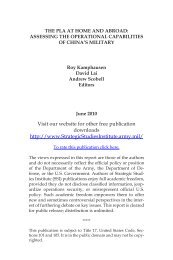The United States and China in Power Transition - Strategic Studies ...
The United States and China in Power Transition - Strategic Studies ...
The United States and China in Power Transition - Strategic Studies ...
Create successful ePaper yourself
Turn your PDF publications into a flip-book with our unique Google optimized e-Paper software.
(尖阁群岛) <strong>in</strong> Japanese <strong>in</strong> the disputed area of the two<br />
nations’ overlapp<strong>in</strong>g ocean claims. It is very difficult,<br />
if not impossible, to see the settlement of one without<br />
the other.<br />
<strong>Ch<strong>in</strong>a</strong> <strong>and</strong> Japan are maritime neighbors on the<br />
two sides of the East <strong>Ch<strong>in</strong>a</strong> Sea, with <strong>Ch<strong>in</strong>a</strong>’s eastern<br />
seaboard from Fujian Prov<strong>in</strong>ce to Shanghai on the<br />
west <strong>and</strong> Japan’s Ryukyu isl<strong>and</strong> cha<strong>in</strong> on the east.<br />
<strong>The</strong> distance between the two sides is about 360 nm<br />
at its widest stretch <strong>in</strong> the north <strong>and</strong> about 200 nm at<br />
the narrowest po<strong>in</strong>ts <strong>in</strong> the south. For centuries, there<br />
was no maritime boundary between <strong>Ch<strong>in</strong>a</strong> <strong>and</strong> Japan.<br />
However, with the birth of UNCLOS, the two nations,<br />
which are parties to the treaty, found the need <strong>and</strong> requirement<br />
to establish proper divid<strong>in</strong>g l<strong>in</strong>es <strong>in</strong> their<br />
shared waters <strong>and</strong> the seabed underneath.<br />
<strong>The</strong> UNCLOS offers two key provisions for the<br />
redistribution of the world’s ocean commons. First,<br />
it encourages ocean littoral nations to claim 200-nm<br />
EEZs off their territorial waters. Second, it also allows<br />
ocean littoral nations with naturally extended underwater<br />
cont<strong>in</strong>ental shelves to exp<strong>and</strong> the jurisdiction<br />
of their cont<strong>in</strong>ental shelves to a maximum of 350 nm<br />
from their seashores.<br />
<strong>The</strong>se “revolutionary” provisions, however, were<br />
bound to create overlapp<strong>in</strong>g claims <strong>and</strong> br<strong>in</strong>g neighbor<strong>in</strong>g<br />
littoral nations to confront each other. Dur<strong>in</strong>g<br />
the long <strong>and</strong> exhaustive negotiations for the Law of<br />
the Sea, nations were divided on how to h<strong>and</strong>le <strong>in</strong>evitable<br />
conflicts result<strong>in</strong>g from overlapp<strong>in</strong>g claims.<br />
Some advocated a one-fits-all “median l<strong>in</strong>e” to settle<br />
overlapp<strong>in</strong>g claims. Others <strong>in</strong>sisted on an “equitable<br />
pr<strong>in</strong>ciple” for claimants to negotiate solutions to their<br />
disputes. <strong>The</strong> two sides could not reach an agreement<br />
at the conclusion of the UNCLOS <strong>in</strong> 1982. <strong>The</strong>y<br />
144

















